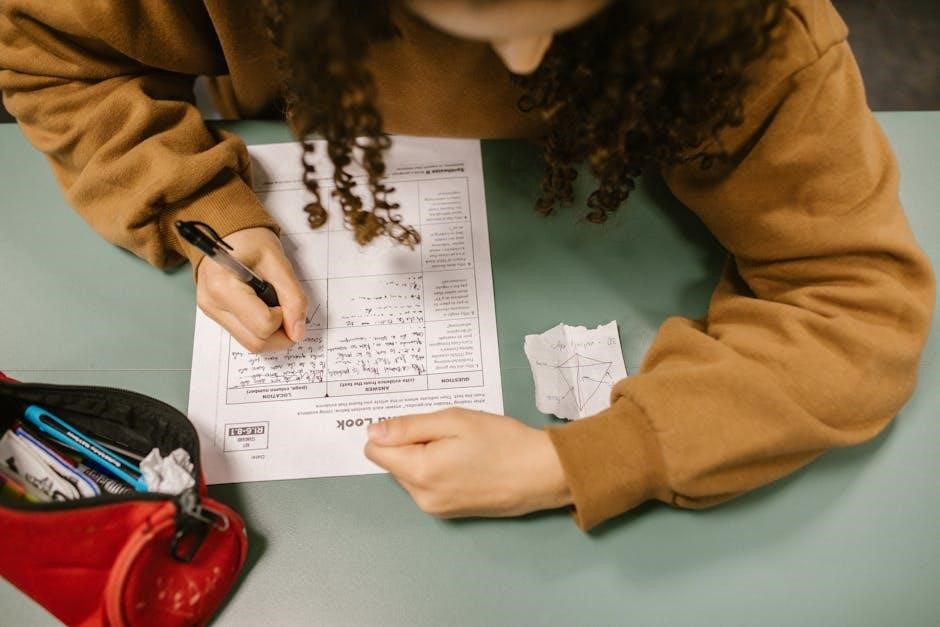A Spanish cheat sheet is a comprehensive guide containing essential phrases, grammar rules, and vocabulary. It serves as a valuable resource for learners, offering quick access to key language elements. These PDF documents are designed to help master Spanish efficiently, covering everything from verb conjugations to common expressions. They are ideal for beginners and travelers, providing a convenient and portable learning tool.

1.1 What is a Spanish Cheat Sheet?
A Spanish cheat sheet is a concise, portable document, often in PDF format, designed to provide quick access to essential Spanish language elements. It typically includes common phrases, grammar rules, verb conjugations, and vocabulary lists. These resources are ideal for beginners and travelers, offering a compact reference guide to master key aspects of Spanish. Cheat sheets are easy to print or save on devices, making them a practical tool for language learners seeking to improve their skills efficiently.
1.2 Importance of Using a Spanish Cheat Sheet for Learning
A Spanish cheat sheet is an essential tool for quick and effective language learning. It provides learners with instant access to key phrases, grammar rules, and vocabulary, helping to accelerate the learning process. These sheets are particularly useful for beginners and travelers, as they simplify complex concepts into a manageable format. By offering a portable and organized resource, cheat sheets enable learners to study anywhere, anytime, making them a valuable companion for mastering Spanish efficiently and confidently.

Spanish Grammar Basics
Spanish grammar involves understanding gender, number, and verb conjugation. It includes noun-adjective agreement, pronoun usage, and sentence structure. Mastering these basics is fundamental for clear communication in Spanish.
2.1 Present Tense Conjugation
The present tense in Spanish is used to describe actions happening now, habitual actions, or general truths. Regular verbs are divided into three groups: -ar, -er, and -ir. For -ar verbs, endings are -o, -as, -a, -amos, -áis, and -an. -Er verbs use -o, -es, -e, -emos, -éis, and -en. -Ir verbs follow -o, -es, -e, -imos, -ís, and -en. Irregular verbs like ser and estar have unique conjugations. Mastering present tense is essential for building a strong foundation in Spanish grammar.
2.2 Preterite and Imperfect Tenses
The preterite tense describes completed actions in the past, while the imperfect tense highlights ongoing or repeated actions. Regular -ar verbs in the preterite end with -é, -aste, -ó, -amos, -asteis, and -aron. -Er and -ir verbs follow similar patterns with slight stem changes. The imperfect tense uses -aba, -abas, -aba, -ábamos, -abais, and -aban for -ar verbs, with -ía, -ías, etc., for -er and -ir verbs. Understanding these tenses is crucial for narrating past events accurately in Spanish.

Spanish Verb Conjugation Guide
This guide provides a clear breakdown of regular and irregular verb conjugations in Spanish, covering present, preterite, and imperfect tenses. It offers structured tables for easy learning, ensuring mastery of verb forms for all learners.
3.1 Regular Verbs (-ar, -er, -ir)
Regular Spanish verbs are categorized by their endings: -ar, -er, and -ir. Each group follows predictable conjugation patterns in the present tense. For -ar verbs, endings are -o, -as, -a, -amos, -áis, and -an. -Er verbs use -o, -es, -e, -emos, -éis, and -en. -Ir verbs follow -o, -es, -e, -imos, -ís, and -en. These patterns are consistent across regular verbs, making them easier to learn and use correctly in sentences. Conjugation charts in cheat sheets provide a quick reference for mastering these verbs.
3.2 Irregular Verbs in the Present Tense
Irregular verbs in Spanish do not follow the standard conjugation patterns of regular verbs. These verbs must be memorized as their endings vary unpredictably. Common irregular verbs include ser (to be), estar (to be), and tener (to have). For example, ser conjugates as soy, eres, es, somos, sois, and son. Cheat sheets often highlight these irregularities, providing clear tables for quick reference. Mastering irregular verbs is essential for constructing accurate sentences in the present tense.
3.3 Preterite Tense for Regular and Irregular Verbs
The preterite tense is used to describe completed actions in the past. For regular verbs, the endings vary by verb type (-ar, -er, -ir). For example, hablar (to speak) becomes hablé, hablaste, habló, hablamos, hablasteis, and hablaron. Irregular verbs, like ser (to be), tener (to have), and venir (to come), do not follow these patterns. For instance, ser conjugates as fui, fuiste, fue, fuimos, fuisteis, and fueron. Cheat sheets often include tables for these conjugations to aid quick learning and reference.
3.4 Imperfect Tense Conjugation
The imperfect tense is used to describe ongoing or repeated actions in the past. For regular verbs, endings are added to the stem: -ía, -ías, -ía, -íamos, -íais, -ían for -ar verbs (e.g., hablaba), and -ía, -ías, -ía, -íamos, -íais, -ían for -er and -ir verbs (e.g., comía, vivía). Irregular verbs like ser (e;g., era, eras) and tener (e.g., tenía, tenías) have unique conjugations. Cheat sheets often summarize these patterns, making it easier to memorize and use them correctly in sentences.

Spanish Vocabulary Essentials
Mastering basic vocabulary is crucial for learning Spanish. This section includes common greetings, numbers, days of the week, months, and useful expressions for everyday situations and travel, providing a solid foundation for beginners.
4.1 Common Greetings and Phrases
Mastering common greetings and phrases is essential for effective communication in Spanish. These include basic expressions like “Hola, ¿cómo estás?” (Hello, how are you?) and “Buenos días” (Good morning). PDF cheat sheets often feature lists of greetings, such as “Hola”, “Adiós”, and “Buenas noches”, along with their English translations. Additionally, phrases like “Por favor” (Please) and “Gracias” (Thank you) are widely used in daily interactions. These resources also cover informal and formal greetings, ensuring learners can communicate confidently in various social settings. Reliable sources like SpanishPod101 and LanguageChimp offer comprehensive PDF guides with these essentials.
4.2 Numbers and Basic Words
Spanish cheat sheets often include essential lists of numbers and basic words to help learners build a strong foundation. These resources typically cover cardinal numbers like uno (one), dos (two), and diez (ten), along with ordinal numbers such as primero (first) and segundo (second). Basic words like hombre (man), mujer (woman), and niño (child) are also included. Many PDF guides organize these words into categories, such as family members, colors, or common objects, making it easier for learners to memorize and practice. These cheat sheets are a convenient way to review vocabulary on the go.
4.3 Days of the Week and Months
Spanish cheat sheets commonly include lists of days of the week and months, essential for everyday communication. The days are lunes (Monday), martes (Tuesday), miércoles (Wednesday), jueves (Thursday), viernes (Friday), sábado (Saturday), and domingo (Sunday). Months include enero (January), febrero (February), marzo (March), abril (April), mayo (May), junio (June), julio (July), agosto (August), septiembre (September), octubre (October), noviembre (November), and diciembre (December). These are often presented in tables or lists, making them easy to memorize and reference. Many PDF guides also include pronunciation tips and common phrases related to time and dates.
4.4 Useful Expressions for Travelers
Spanish cheat sheets often include essential phrases for travelers, such as asking for directions, ordering food, and making purchases. Common expressions like ¿Dónde está…? (Where is…?), ¿Cuánto cuesta? (How much does it cost?), and Un billete para… (A ticket to…) are invaluable. Phrases like La cuenta, por favor (The check, please) and ¿Habla inglés? (Do you speak English?) are also included. These expressions help travelers navigate everyday situations, making the cheat sheet a must-have resource for anyone visiting Spanish-speaking countries. Many PDF guides also offer tips for pronunciation and context usage, ensuring practical application.

Spanish Phrases for Everyday Use
Mastering everyday phrases like greetings, asking for directions, and ordering food is crucial. Cheat sheets provide phrases like ¿Dónde está…?, Por favor, and ¿Cuánto cuesta?, essential for daily interactions and travel.

5.1 Introducing Yourself
Introducing yourself in Spanish is a fundamental skill. Key phrases include “Me llamo” (My name is), “Soy de” (I am from), and “Tengo X años” (I am X years old). These expressions help establish basic communication. Cheat sheets often list these phrases alongside their English translations for easy reference. Additionally, they may include questions like “¿De dónde eres?” (Where are you from?) and “¿Cuál es tu nombre?” (What is your name?). These tools are designed to make learning and using these phrases straightforward and accessible for travelers and learners alike.

5.2 Asking for Directions
Asking for directions in Spanish is made easier with essential phrases like “¿Dónde está…?” (Where is…?) and “¿Por favor, puede ayudarme?” (Can you please help me?). Cheat sheets often include maps, vocabulary for directions, and common expressions such as “izquierda” (left), “derecha” (right), and “recto” (straight). They also provide phrases like “¿Cómo se llama este lugar?” (What is this place called?) and “Estoy perdido/a” (I am lost). These resources are designed to help learners navigate confidently in Spanish-speaking environments, making travel and communication more accessible and efficient.
5.3 Ordering Food and Drinks
Mastering how to order food and drinks in Spanish is essential for any traveler or learner. A Spanish cheat sheet provides phrases like “Un café, por favor” (A coffee, please) and “La carta, por favor” (The menu, please). It also includes expressions for specifying preferences, such as “Sin gluten, por favor” (Gluten-free, please) and “¿Qué recomiendas?” (What do you recommend?). Additionally, cheat sheets often list common food and drink vocabulary, such as “tortilla” (omelet), “paella”, and “cerveza” (beer). These resources ensure learners can confidently navigate restaurant interactions and enjoy authentic dining experiences in Spanish-speaking countries.
5.4 Shopping and Making Purchases
A Spanish cheat sheet for shopping includes essential phrases like “¿Cuánto cuesta esto?” (How much does this cost?) and “¿Dónde está el baño?” (Where is the restroom?). It also provides expressions for trying items, such as “¿Tiene esto en mi talla?” (Do you have this in my size?) and “Me gustaría comprar…” (I would like to buy…). Cheat sheets often list numbers and basic words like “caro” (expensive) and “barato” (cheap), helping learners negotiate and make confident purchases in Spanish-speaking markets or stores.
5.5 Emergency Phrases
A Spanish cheat sheet for emergencies includes vital phrases like “¡Ayuda!” (Help!) and “¡Socorro!” (Help!). It also covers medical needs, such as “Necesito un médico” (I need a doctor) and “¿Dónde está el hospital más cercano?” (Where is the nearest hospital?). Phrases for police assistance, like “Llame a la policía” (Call the police), are also included. Additionally, cheat sheets often list expressions for fire situations, such as “¡Fuego!” (Fire!) and “¿Dónde está la salida de emergencia?” (Where is the emergency exit?).
5.6 Common Questions and Responses
Spanish cheat sheets often include essential questions and responses for everyday interactions. Common questions like “¿Cómo estás?” (How are you?) and “¿Cuál es tu nombre?” (What is your name?) are paired with responses like “Estoy bien, gracias” (I’m fine, thank you) and “Me llamo…” (My name is…). They also cover basic inquiries such as “¿De dónde eres?” (Where are you from?) and “¿Hablas inglés?” (Do you speak English?). These phrases help learners navigate simple conversations effectively, making communication smoother in Spanish-speaking environments.

Resources and Tips for Learning Spanish
Utilize SpanishPod101 for free PDF lessons covering topics like weather and family. Download cheat sheets from Linguajunkie.com for writing practice. Explore tools like Spanish verb guides and vocabulary workbooks to enhance your learning journey.
6.1 Popular Spanish PDF Cheat Sheets Available Online
Discover a variety of Spanish PDF cheat sheets designed to simplify learning. SpanishPod101 offers free downloadable lessons covering essential topics. The 50 Spanish Verbs Cheat Sheet provides conjugations for quick reference. Similarly, Basic Spanish Cheat Sheet by Cheatography includes grammar, vocabulary, and phrases. These resources are ideal for beginners, offering a structured approach to mastering the language. They are easily accessible and printable, making them perfect for on-the-go learning. Explore these tools to enhance your Spanish skills efficiently.
6.2 How to Use a Spanish Cheat Sheet Effectively
To maximize the benefits of a Spanish cheat sheet, start by setting clear learning goals. Focus on specific areas like grammar, vocabulary, or phrases. Regularly review the content, practicing pronunciation and usage. Use the cheat sheet to supplement your studies, cross-referencing with other materials. Prioritize high-frequency phrases for practical communication. Engage actively by writing down new words and testing yourself. Carry the PDF version for quick reference during travels or conversations. Regular review and application will help reinforce your Spanish skills and build confidence.
6.3 Additional Study Materials and Tools
Beyond cheat sheets, learners can benefit from interactive language apps like Duolingo or Babbel for regular practice. Audio resources and podcasts enhance listening skills, while flashcard apps like Anki aid vocabulary memorization. Structured courses from platforms like SpanishPod101 offer comprehensive lessons. Language exchange programs connect learners with native speakers for real conversations. Additionally, practice workbooks and grammar guides provide in-depth exercises. Combining these tools with cheat sheets creates a well-rounded study routine, catering to different learning styles and accelerating progress in mastering Spanish.



